Live Streaming Statistics And Facts For 2020

Live streaming transmits the information through audio and video in real-time; it gets recorded and broadcast simultaneously. Earlier people used to download videos and audios on mobile phones, which was time-consuming. More and more internet users are now preferring to watch live streams online rather than downloading them.
Overview of Live Streaming Statistics And Facts For 2020
- 1 Live Streaming Statistics And Facts For 2020
- 2 Age-wise distribution
- 3 Market and revenue statistics
- 4 Platform usage statistics:
- 5 Interesting statistics:
- 6 Mobile Streaming Statistics
- 7 Audio / Music streaming
- 8 Streaming music revenue:
- 9 Global music streaming user statistics:
- 10 Live streaming market share by reputed brands for the year 2019:
- 11 Podcast streaming statistics
- 12 The behavior of audience and statistics:
- 13 Preference of viewers watching live stream contents:
- 14 Viewership pattern and statistics of live streaming:
- 15 Live streaming and business:
- 16 Real status on live streaming:
- 17 Conclusion
Live streaming provides real-time uncensored content. It is an alternative to file downloading. The major problems in transmitting video files are its file size. Streaming chops the video files in pieces and sends them to your device one at a time. As life is pretty fast nowadays, everyone wants to save time, and so people are selecting live-streamed content for all chunks of information and entertainment.
The demand for live streaming content has grown massively, and it has become an inevitable part of the business to stay connected with the customers for creating consumer awareness and marketing. In this article, let us discuss the various statistics and demography of live streaming.
Live streaming - insight on consumer behavior
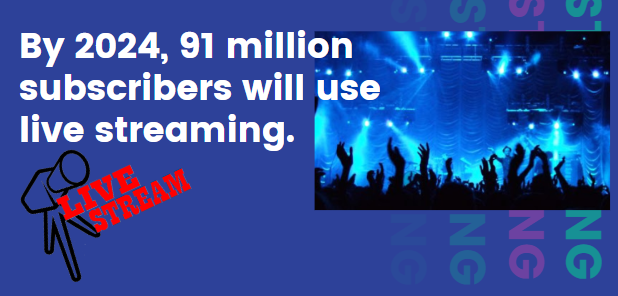
- By 2024, 91 million subscribers will use live streaming. (TV Technology)
- 45% of the audiences are willing to pay for accessing live streaming content. (Livestream)
- 80% of people prefer watching a live streaming video rather than reading a blog or an article. (Livestream)
- Live streaming topped 1.1 billion hours in 2019. (Stream Elements)
- 67% of audiences book tickets of a particular event after watching its live demo. (Livestream)
- By 2021, the streaming industry is estimated to reach $70.05 billion (PR Newswire)
- 56% of audiences watch live streaming news content. (GoGlobe)
- LinkedIn reported that video with ads gets 30% more engagement than non-video ads. ( TechCrunch )
- 44% of people said that they watch more live streaming content online than watching live TV. ( IAB)
Age-wise distribution
The viewership of live streaming always varies according to age. The following statistics will help you to understand the pattern of viewership as per the age.
- 20% of people ranging from 18 to 24 years enjoy streaming music. (Statista)
- 47% of Americans within the age group of 18-34 are likely to have three steaming service subscriptions, and 31% will have two subscriptions. (BusinessOfApps)
- In the age group of 25 to 34 years, 37% of people prefer music streaming. (Statista)
- As of May 2019, the YouTube screening on TV monitors has crossed 250 million+ hours per day, as announced by Susan Wojcicki, CEO YouTube. (Variety)
- On a Year to Year comparison, by March 2019, YouTube screening on TV monitors has registered a 39% increase from 180 million hours of March 2018. (Variety)
- 23% of people in the age group of 35 to 44 like to enjoy stream music. (Statista)
- 13% of consumers ranging from 45 to 54 years prefer live stream music. (Statista)
- 4% audiences for live music streaming belongs to the age group of 55 to 64. (Statista)
- 42% of viewers are within Gen X, i.e., within the 35-54 age group (Forbes)
- 58% are single. (Forbes)
- 78% live in urban or suburban locations. (Forbes)
- 50% have a college education. (Forbes)
- 50% have kids. (Forbes)
Market and revenue statistics
Live streaming is a significant activity for revenue generation. Many companies have exclusive marketing division for live streaming. In this segment, let us check the global revenue generation of some of the market leaders.
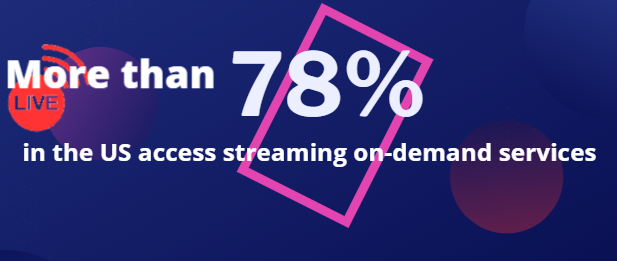
- More than 45% of households in the US access streaming on-demand services (Statista)
- According to the Grand View Research, the video streaming industry will see a growth of 19.6% from 2019 and will reach $124.57 billion by 2025. (Grand View Research)
- Netflix registered revenue of about $17.63 billion in 2019. ( Macrotrends)
- Netflix had 159 million viewers from the US. (Statista)
- Amazon spent $7 billion in 2019 on video and music content. (CNBC)
Platform usage statistics:
A great platform really matters in this industry. YouTube, Netflix, Amazon Prime are some of the most popular platforms that are into live streaming. Let us have a look at these statistics.
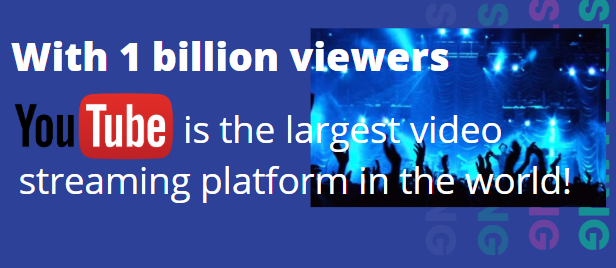
- YouTube is one of the largest video streaming platforms, globally. YouTube has more than 1 billion viewers. (YouTube)
- On June 30, 2019, Netflix had more than 151 million paid subscribers and 6.5 million free trial streaming users. (Statista)
- Around 60.1 million Netflix subscribers are from the United States. (Statista)
- Netflix has 91.46 million international subscribers. (Netflix)
- iQIYI video streaming has 454.5 million active monthly users. (iQIYI)
- iQIYI video streaming service has 100 million paid subscriptions. (TechinAsia)
- As of March 2020, Netflix enjoys a market cap of $163 billion. (BusinessofApps)
- Twitch had over 3 million video streaming audience in July 2019. ( Twitch Tracker)
- As per the 2020 report, Amazon Prime had 17 million video viewers than Hulu. (Reelnreel)
- At present, Amazon Prime video service has 75 million videos globally, including 40 million videos in the US. The US viewership will cross 100 million by 2020 as per industrial estimate. (Reelnreel)
- Based on 2020 statistics, Amazon Prime Music has 500 million subscribers. (Reelnreel)
- 10 million people took a paid subscription for Amazon music video unlimited in 2019. (Reelnreel)
- As of 2020, the Amazon Prime subscription may reach 164 million. (Reelnreel)
Interesting statistics:
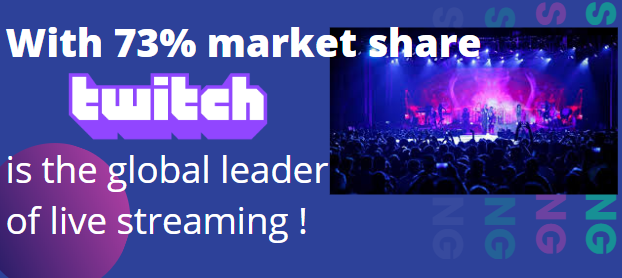
- Twitch is the leader of the live streaming market, with a market share of 73% when measured by hours watched. (StreamElements)
- Video streaming user spends an average of 1.6 hours per day on iQIYI live streaming platform. (iQIYI )
- In a month, consumers spend 9.4 billion hours on the iQIYI platform. (iQIYI )
- By 2020, there will be almost a million minutes of video per second crossing the internet. 82% of all consumer web traffic will be video. (Dacast)
- If the criteria for selecting the biggest live streaming platform in the world is the total hours watched by the viewers, then Twitch would naturally be fit for that post. In 2019, Twitch streamed more than 9.3 billion hours. (StreamElements)
- Comparing to a YoY growth rate, Facebook Gaming registered 210% growth in 2019 than 2018, with 350+ million hours streaming watched. (StreamElements)
- When it comes to live-game streaming, Twitch controls 72.2% of streaming, YouTube controls over 19.5%, Facebook Gaming goes with 5.3%, and Mixer controls a 3% share. (StreamElements)
Mobile Streaming Statistics
Nowadays, most information can easily access on smartphones. It is also the main factor behind the increased revenue of the video and music industry. YouTube says that 70% of its watch time comes from mobiles. With the growing impact of the internet and easily accessible content, 65% of people stream live content online.
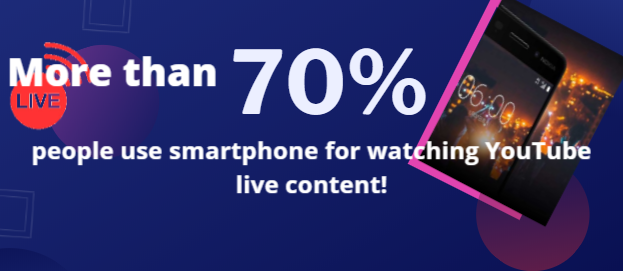
- More than 70% of people use a smartphone for watching YouTube content. (YouTube)
- iQIYI has 135.4 million daily mobile users. (iQIYI)
- 80% of the US viewers say that variety in the music is the important factor in live music streaming. (g2)
- 30% of the Americans are unfamiliar with the podcasts. (g2)
- 92% of video viewers share the content with others. (Wordstream)
- 90% of Twitter videos watched on mobile gadget. (Wordstream)
- More than half of total video content viewed by the users on mobile. (Wordstream)
Audio / Music streaming
The most potent industry after live streaming videos is definitely the music industry. Previously people used to download audios or music like songs on their mobiles or laptops, but now more and more people are opting for live streaming music.
Here are some statistical representations that will help us understand the overall consumption of live music.
- The rise of the audio streaming witnessed a decline of 21% in the download revenue. Audio streaming had a 10% drop in overall physical revenue. (IFPI)
- In 2019, both Germany and the UK crossed the 100bn mark in annual audio music streaming. Germany recorded 107bn, and the UK registered 114bn streaming. (Musically)
- In 2019, Americans had 1.15tn music on-demand streaming. (Musically)
- Apple Music had 28 million subscribers in Feb 2019, which was 2 million more than Spotify ‘s paid subscribers. (Reuters)
Streaming music revenue:
- In 2020, the USA expects to register a revenue of $12,435m in live streaming. (Statista)
- As per an estimate, from 2020 to 2024, the music stream revenue will show a growth rate of 5.7% per year, and the market will have a volume of US $15,520m revenue by 2024. (Statista)
- In 2020, the user penetration will be 14.6%, and it may reach to 16.5% by 2024. (Statista)
- Presently, the average revenue per user (ARPU) is the US $11.4. (Statista)
Global music streaming user statistics:
The growth of the worldwide music market is directly related to streaming activities. Music recording companies throw their support to performers to get connected with their fans globally, which helps the market to grow further. Live streaming of music helps to develop a strong connection with the fans, which directly contributes to the growth of the music industry.
- 6% of user penetration expects by 2020. (musically)
- The global project for 2020 is 450 million subscriptions for the year 2020. (counterpointresearch)
- The expected user penetration for 2024 is 16.5% (musically)
- The expected market volume for 2024 is US$ 15,520 million. (musically)
- Global music streaming subscription shows a 32% YoY increase. (patentlyapple)
- Global music streaming touched 350+ million subscriptions in 2019. (counterpointresearch)
- Spotify dominated the global streaming market with 23% YoY growth in 2019. (counterpointresearch)
- By 2030 the streaming alone will worth US$37.2 billion. (musically)
- By 2026, consumer spending on steaming will cross US$45.3 billion. (musically)
Live streaming market share by reputed brands for the year 2019:
Spotify continues to flex its muscle in the live streaming industry, followed by Apple Music. Many other live streaming bands such as Amazon Music, Tencent Music, YouTube Music are closely competing with each other. Apart from the major players, there are many local players like Gaana in India, Anghami in the Middle East, Yandex Music in Russia, which are having notable performance in the respective market. On a general outlook the stream statistics as per brands share are as follows: (counterpointresearch)
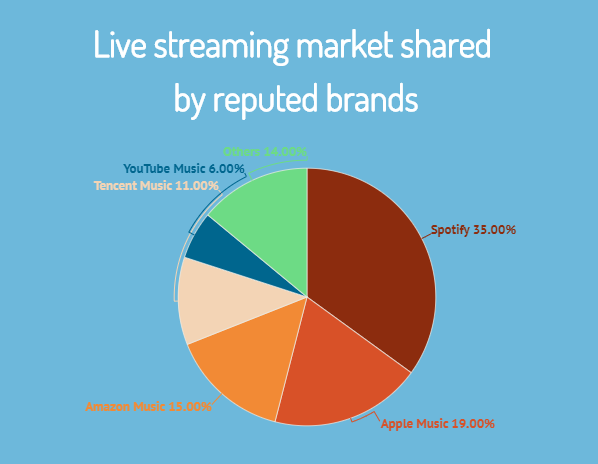
- Spotify: 35%
- Apple Music: 19%
- Amazon Music: 15%
- Tencent Music: 11%
- YouTube Music: 6%
- Others: 14%
Podcast streaming statistics
- The podcast industry and revenue are speculated to grow by 42%, to reach over $680 in 2019. (IAB)
- By 2020, the entire podcast industry will grow over 110% to reach $659 million. (IAB)
- The top 5 podcast revenue generators in program category are news/current affairs/politics(18.4%),Comedy(13.9%),business (12.8%),education (10.6%) and arts and entertainment(10%) (IAB)
- The top podcast revenues in business category includes retail(22.2%), B2B (14.1%), financial services (20.7%) arts and entertainment (9.6%) and telecommunication (7.1%) (IAB)
The behavior of audience and statistics:
- The brand spent about $90 billion in 2018 for live content, and it may rise to $100 billion by 2023. (Livestream)
- 79% of live viewers believe that live streaming gives an authentic interaction. (Techjury)
- By 2021 the live streaming industry may grow up to $70.5 billion. (Livestream)
- The number of video stream viewers has increased by 47% than the previous year globally. (Techjury)
- Comparing to the previous year, 47% of live video streamers are viewing more live videos. (Livestream)
- Among millennials, 74% say live streaming is helpful for shopping. (Techjury)
- 44% watch less live TV programs because of live-streaming. (Livestream)
- Internet traffic can expect an 82% increase by 2020 because of live streaming. (Techjury)
- A comparison between 2017 and 2018 confirms that 65% live-stream content increases. (Livestream)
- 87% of commercial entities use live streaming in 2019, which shows an increase of 81% from 2018. (Techjury)
- Steaming on social media generates 1200% more shares comparing with images and texts. (Techjury)
- 40% of customers confirm that steaming increases the chance to close a purchase deal on the mobile device. (Techjury)
- 80% of customers prefer watching a brand live streaming than reading a product review or blog. (Techjury)
- 63% of consumers within the age group 18-34 regularly watch live streaming. (Techjury)
- 56% of the most-watched live content is the breaking news. (Techjury)
- Video ads make 30% more engagements, as reported by LinkedIn. (Livestream)
- 43% of live-stream viewers think that they watch live stream content if the subject is compelling. (Techjury)
Preference of viewers watching live stream contents:
- 29% prefer watching sports items. (martechadvisor)
- 30% opt for watching content streamed by friends and family members. (martechadvisor)
- 38% prefer watching live concerts and events. (martechadvisor)
- 41% exclusively watch breaking news. (martechadvisor)
- 53%, which is the majority of viewers love watching entertainment and funny live stream contents. (martechadvisor)
Viewership pattern and statistics of live streaming:
- 63% of Millennials within the age group of 18-34 are the biggest segment of consumers who watch live streaming. (dacast)
- Young millennials watch live streaming on smartphone/digital devices than on TV. (dacast)
- More than 3 million viewers canceled cable subscriptions in 2019 because of live streaming. (dacast)
- 56% of millennials watch live streaming on smartphones and 44% watch on tablets. (dacast)
- People spend 2.8 minutes for VoD and 3.5 minutes for watching live streaming on a smartphone. (dacast)
- On average people spend 4.1 minutes on tablets for watching VoD and 7.1 minutes on tablets. (dacast)
- People spend, on average, 34.5 minutes on the desktop for viewing live streaming and 2.6 minutes for VoD. (dacast)
- The time viewers spend on watching live streaming is 8 times more than that of VoD. On average people spend 42.8 minutes for live streaming and 5.1 minutes for VoD. (dacast)
Live streaming and business:
Lives streaming is the trend of business marketing, as it can enhance the brand image in different ways. It allows the buyers to have direct access to the product and services at a low cost. It is one of the simplest ways to introduce the product/service to the customers. Live steam means it is an unedited content beam to the viewers with an ability to create an in-depth personal experience. The following data will give us some interesting information on the live stream and how it impacts the business.
- Buffering is the common problem that happens while live streaming and 77% of people have reported this on a recent survey. (dacast)
- About 55% of companies are using live streaming to promote their brand image. (dacast)
- 53% of companies live stream within their organization weekly once, out of the 53% companies, 29% carry out a daily broadcast. (dacast)
- 65% of companies do live streaming in more than one location. (dacast)
- 41% of companies felt it is challenging to live stream for remote working employees. (dacast)
- 81% of live broadcasts display on employee desktops, 64% use mobile for viewing, and 31% use TV. (dacast)
Real status on live streaming:
- 80% of viewers prefer to watch live streaming than reading posts. (martechadvisor)
- 63% of millennials watch live broadcasts. (martechadvisor)
- 10 million active users watch daily Twitch, the biggest live streaming platform. (martechadvisor)
- Facebook live stream has 3X more customers than regular ones. (martechadvisor)
- Since Facebook Live’s Rollout, its popularity has increased by more than 330%. (martechadvisor)
Conclusion
Live streaming comes with a lot of conveniences. It is exciting to watch live stream content as it renders real-time engagements. Because of the availability of sophisticated gadgets, live streaming has become a common activity, and even an ordinary person can stream live content through their favorite social media. In the corporate segments, it uses to make real-time engagements with the audiences and thus improve the brand image. Live stream, let the audience stay connected, and it also helps to increase the web traffic. As a result, there will be more business conversions.
Source links:
https://www.patentlyapple.com/patently-apple/2020/04/global-online-music-streaming-grew-32-year-over-year-with-spotify-continuing-to-dominate-the-market-due-to-its-free-tier.html
Global Online Music Streaming Grew 32% YoY to Cross 350 Million Subscriptions in 2019
Analysis: the music industry enters 2020 on a wave of growth – and optimism
https://livestream.com/blog/62-must-know-stats-live-video-streaming
Live Streaming Statistics Every Marketer Should Keep In Mind in 2020
https://www.martechadvisor.com/articles/interactive-marketing/live-streaming-as-a-way-to-establish-your-brand-on-social-media/
https://www.wordstream.com/blog/ws/2017/03/08/video-marketing-statistics
Explore Related reccomendations
TikTok Statistics, Usage And Facts (2020 Report)
- According to 0 users
Netflix Statistics And Facts For 2019
- According to 0 users
Dropbox Statistics, Users, Growth And Facts For 2021
- According to 0 users
Facebook live Statistics, Usage And Facts (2020 Report)
- According to 0 users


